The Most Common Problems Students in Japan Face When Learning English

Japan is a country facing rapid change. Due to an aging population and a scarcity of workers, Japan is opening its borders to foreigners, many of whom speak English. This, along with the upcoming Tokyo Olympics, has led to an increase in demand for English teachers. I currently work in Japan, and have had the experience of teaching English to high school Japanese students for the past year. Over the course of this year, I've learned of many problems that students in Japan face when learning English. Of those, the top three problems for students in Japan are pronunciation, shyness, and large class sizes.
Table of Contents
Class Size in Japanese Schools
Are you ready to teach English in Japan?
Check out what our course grads say in our many video testimonials!
This post was written by our ITTT graduate Kaavya P.
Listen to this blog post:
Differences in Phonology
The phonology of the Japanese language is such that every sound ends in a vowel, save for one- the 'n' sound. It is very difficult for students to become accustomed to, and pronounce, the hard consonant sounds of English. Students face an additional barrier in the form of 'wasei Eigo,' or loan words from English. These words are commonplace, and use the Japanese phonology. So for students used to saying 'kanningu,' the word 'cunning' is very difficult to pronounce. In addition, meanings have shifted as words have been adopted. Cunning, for example, is a word used to refer to cheating on a test, and not someone who is exceptionally clever, as it does in standard English. So, Japanese students face many problems as they adjust to the phonology and meanings of standard English.

Students' Reluctance to Speak
Another major problem students face here is shyness. Japan is a collectivist society. The emphasis is on the group here. Thus, students are often reluctant to speak out or state their own opinions separate from the group. This becomes a problem in the English classroom, as many assignments designed to practice spontaneous creation of language rely on students speaking their minds. Often, even students with advanced English ability are reluctant to participate in assignments such as debates, which are common place in the foreign language classroom in Western countries. As I've learned, it isn't common in the Japanese education system for students to engage in creative assignments. Even in their native-language classes, lessons tend to focus on concrete facts rather than on creativity. Even young students struggle with this, and for high school students, being asked to imagine what comes next in a story can invoke great anxiety, and a further reluctance to participate in the class. This is a problem not only in my classroom, but in classrooms across the country.
Join our TEFL in-class course in Tokyo and become TEFL/TESOL certified in Japan.

Class Size in Japanese Schools
The final problem I will discuss is class size. English is becoming a required subject for many Japanese students, starting from elementary school. However, class sizes tend to be quite large. Thirty to forty students make up a homeroom class on average. This works fine for regular, lecture-based classes. For foreign language classes, it becomes a problem. With so many students in one room, it becomes very difficult for students to work in small groups and for teachers to be able to help individual students with their English. In such large classes, it is easy for the noise level to get overwhelming, and for shyer, quieter students to slip through the cracks and get away with not speaking or participating in assignments. Thus, despite many Japanese students studying English as a subject for ten or more years, the majority of Japanese adults cannot speak English.

Are you ready to teach English in Japan?
In my one year of teaching English in Japan, I've learned a lot about being an English teacher, and a teacher in general. However, the problems mentioned above, as well as many others plaguing the English education system here, make it very difficult for the vast majority of students in Japan to have meaningful language learning experiences. A teacher who wishes to work in Japan in the public school system will have to adapt their teaching practices, often in ways that don't agree with current educational literature, in order to meet the requirements of their employer and the education department. Still, an English teacher can easily find jobs here, and make a difference in the lives of learners. Despite all of these problems facing learners in Japan, it is still a wonderful country to live and teach in, and one I recommend to aspiring EFL teachers.
Apply now & get certified to teach english abroad!
Speak with an ITTT advisor today to put together your personal plan for teaching English abroad.
Send us an email or call us toll-free at 1-800-490-0531 to speak with an ITTT advisor today.
Related Articles:
- Step-By-Step Guide To Legally Teaching English in Japan
- Teaching English in Japan - Alumni Report by Gabriella S.
- The 10 Best Destinations for Teaching English Abroad in 2018
- The Best Government Programs For Teaching English Abroad
- The Top 5 Places to Teach English in Japan
- How much can I earn teaching English in Japan?



